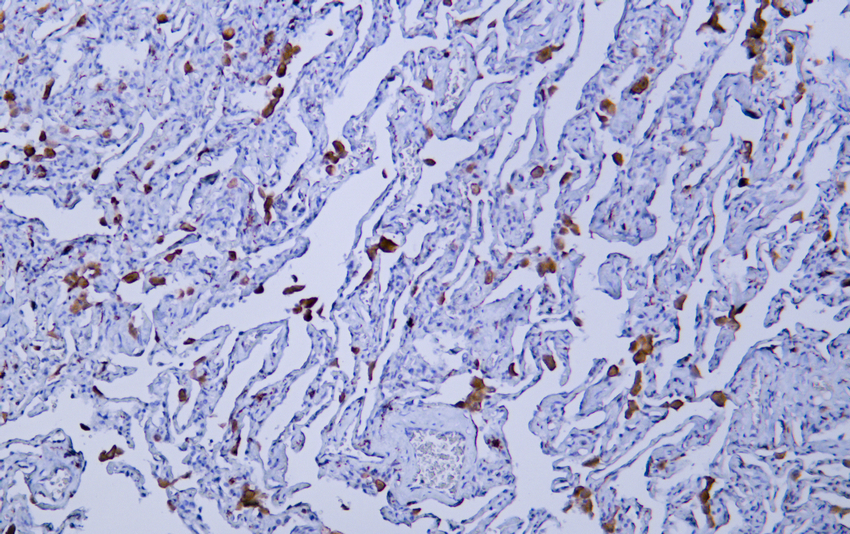CD163 (ABT-CD163) mouse mAb (Ready to Use)
- Catalog No.:YM6146R
- Applications:IHC
- Reactivity:Human;
- Target:
- CD163
- Gene Name:
- CD163 M130
- Protein Name:
- Scavenger receptor cysteine-rich type 1 protein M130 (Hemoglobin scavenger receptor) (CD antigen CD163) [Cleaved into: Soluble CD163 (sCD163)]
- Human Gene Id:
- 9332
- Human Swiss Prot No:
- Q86VB7
- Immunogen:
- Synthesized peptide derived from human CD163 AA range: 1-100
- Specificity:
- The antibody can specifically recognize human CD163 protein.
- Formulation:
- The prediluted ready-to-use antibody is diluted in phosphate buffer saline containing stabilizing protein and 0.05% Proclin 300
- Source:
- Mouse, Monoclonal/IgG1, kappa
- Dilution:
- Ready to use for IHC
- Purification:
- The antibody was affinity-purified from ascites by affinity-chromatography using specific immunogen.
- Storage Stability:
- 2°C to 8°C/1 year
- Background:
- The protein encoded by this gene is a member of the scavenger receptor cysteine-rich (SRCR) superfamily, and is exclusively expressed in monocytes and macrophages. It functions as an acute phase-regulated receptor involved in the clearance and endocytosis of hemoglobin/haptoglobin complexes by macrophages, and may thereby protect tissues from free hemoglobin-mediated oxidative damage. This protein may also function as an innate immune sensor for bacteria and inducer of local inflammation. Alternatively spliced transcript variants encoding different isoforms have been described for this gene. [provided by RefSeq, Aug 2011],
- Function:
- caution:It is uncertain whether Met-1 or Met-6 is the initiator.,disease:The soluble form (sCD163) in plasma is a novel parameter in diseases affecting macrophage function and monocyte/macrophage load in the body. The concentration of sCD163 is probably reflecting the number of macrophages of the 'alternative macrophage activation' phenotype with a high CD163 expression playing a major role in dampening the inflammatory response and scavenging components of damaged cells. This has initiated a number of clinical studies for evaluation of sCD163 as a disease marker in inflammatory conditions e.g. infection, autoimmune disease, transplantation, atherosclerosis and cancer.,domain:The SRCR domain 3 mediates calcium-sensitive interaction with hemoglobin/haptoglobin complexes.,function:Acute phase-regulated receptor involved in clearance and endocytosis of hemoglobin/haptoglobin complexes by ma
- Subcellular Location:
- Membranous, Cytoplasmic
- Expression:
- Expressed in monocytes and mature macrophages such as Kupffer cells in the liver, red pulp macrophages in the spleen, cortical macrophages in the thymus, resident bone marrow macrophages and meningeal macrophages of the central nervous system. Expressed also in blood. Isoform 1 is the lowest abundant in the blood. Isoform 2 is the lowest abundant in the liver and the spleen. Isoform 3 is the predominant isoform detected in the blood.
- June 19-2018
- WESTERN IMMUNOBLOTTING PROTOCOL
- June 19-2018
- IMMUNOHISTOCHEMISTRY-PARAFFIN PROTOCOL
- June 19-2018
- IMMUNOFLUORESCENCE PROTOCOL
- September 08-2020
- FLOW-CYTOMEYRT-PROTOCOL
- May 20-2022
- Cell-Based ELISA│解您多样本WB检测之困扰
- July 13-2018
- CELL-BASED-ELISA-PROTOCOL-FOR-ACETYL-PROTEIN
- July 13-2018
- CELL-BASED-ELISA-PROTOCOL-FOR-PHOSPHO-PROTEIN
- July 13-2018
- Antibody-FAQs
- Products Images

- Human lung tissue was stained with anti-CD163(ABT-CD163) antibody.

- Human malignant fibrous histiocytoma tissue was stained with anti-CD163(ABT-CD163) antibody.

- Human placenta tissue was stained with anti-CD163(ABT-CD163) antibody.



